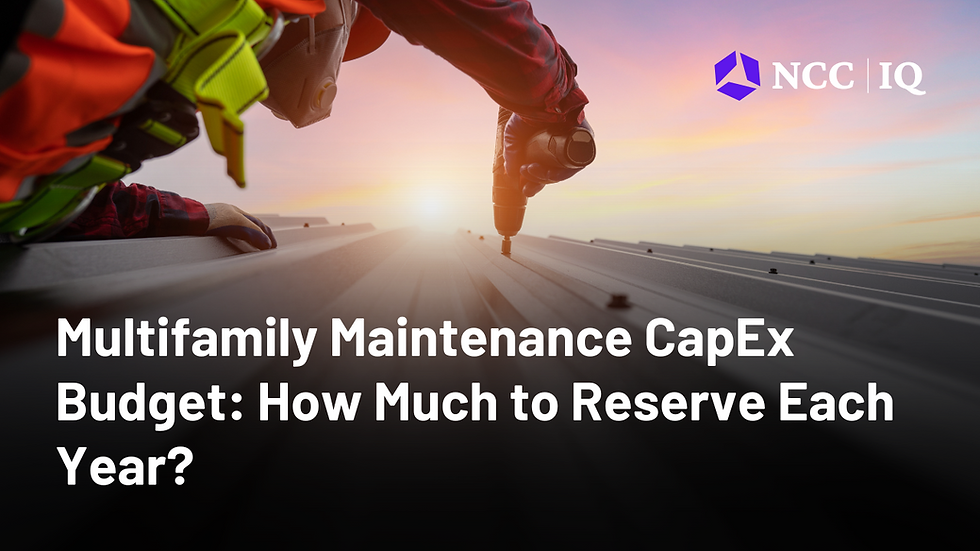Multifamily Maintenance CapEx Budget: How Much to Reserve Each Year?
- NCC IQ

- Aug 10
- 4 min read
An unexpected boiler failure at midnight can erase months of cash flow faster than an enthusiastic lender can say “deferred maintenance.” Prudent ownership asks a simpler question long before that call comes in: How much money should sit in the reserve account every year?
OpEx Versus CapEx - A Fast Refresher
Operating expenses keep the lights on day-to-day. Capital expenditures (CapEx) replace worn-out building systems, extend asset life, and, in many cases, satisfy lender covenants.

Government-sponsored enterprises have clear views on this point.
Fannie Mae updated its Multifamily Guide and now calls for a minimum $300 per unit, per year replacement reserve on most properties without skilled-nursing components. FHA-insured debt often uses $250 per unit, per year as a floor, subject to a formal Property Capital Needs Assessment. Many private debt funds and life-company lenders follow suit.
Yet a single national benchmark can hide the real story. Vintage, climate, construction quality, and improvement plans all shift the right number - sometimes by hundreds of dollars per door.
Age Matters: A Quick Reference Table
Property vintage | Common exterior materials | Typical annual reserve per unit |
2015-present | Fiber-cement siding, PVC roofs, high-efficiency HVAC | $200-$300 |
2000-2014 | Vinyl or hardboard siding, composition roofs | $250-$350 |
1980-1999 | Wood siding, original aluminum wiring, R-22 HVAC | $350-$450 |
Pre-1980 | Flat-top modified bitumen roofs, cast iron plumbing | $450-$600 |
This table does not replace a third-party inspection. It offers a directional range that syndicators can drop into a pro forma while under contract.
Where The Money Actually Goes
Roof systems-20 to 25-year life in temperate regions; sooner in hail country.
HVAC packs or split systems - 12- to 15-year life; recent refrigerant rules shorten that window.
Parking lots - Restriping every three years, milling and overlay every eight to ten.
Exterior paint and sealant - Five- to seven-year cycle, faster near the coast.
Unit interiors - Flooring at turnover seven, cabinets usually match roof life, appliances roughly ten.
Vertical transport - Elevator modernization every 20-25 years, a six-figure ticket.
Many operators treat these line items as future-self problems. Equity partners read those operating memos very differently.
Turning Raw Estimates Into a Line Item
A practical formula keeps underwriting honest:
Annual reserve per unit = (Total forecast CapEx over analysis window) ÷ (Years in window) ÷ (Number of units)
Example: A 100-unit, 1985 build in Phoenix shows $2.8 million of projected replacements over the next 12 years.
$2,800,000 ÷ 12 ÷ 100 = $233 per unit, per year
That sounds low until the roof bid arrives at $480,000 in year 9, pushing the average above $350. Spreadsheet gymnastics give emotional comfort, yet component timing matters more. Many sponsors now add a “lump-sum kicker” in the first two years to guard against surprises during the renovation ramp.
Inflation, Supply Chain Swings, and the New Normal
Materials tracked by the Bureau of Labor Statistics rose roughly 32% from January 2020 through December 2023. Labor escalated 18% in the same period. A reserve rule written five years ago will miss the mark if it ignores that surge. Some groups layer a 3%-4% compound inflation factor on every future outlay, while institutional partners frequently require a minimum 10% contingency on each major project in the first five years.
Factors That Push the Needle Higher-Or Lower
Climate severity - Freeze-thaw cycles punish façades; salt air destroys metal fixtures.
Deferred maintenance inherited at purchase – Past neglect often means higher near-term spending.
Unit upgrade strategy - Converting a C-class building to B-class digs extends useful life of interiors but consumes reserve dollars up front.
Mechanical system type - Chilled-water plants concentrate risk; individual heat pumps spread it out.
Local code changes - Electric stove mandates, refrigerant phase-outs, or mandatory green requirements reshape future outlays.

Stress-Testing the Number
Reserve planning is more art than pure math.
A few tactics tighten the margin for error:
Benchmark three properties of similar age in the same metro and average their CapEx over the past decade.
Map life-cycle events in a Gantt chart instead of a simple annual column; discipline emerges when large dots cluster in one year.
Layer sensitivity bands - reserve at 100%, 125%, and 150% of the baseline—and watch debt-service coverage under each scenario.
Link reserve draws to NOI hurdles rather than calendar years, shielding distributions when revenue dips.
Placing Reserves During Syndication
Investors care less about labels - “repair escrow,” “replacement escrow,” “CapEx reserve”—and more about timing and transparency. Offer memoranda that break down major categories, list assumed inflation, and explain lender requirements win trust quickly. If the deal includes zero annual reserve, expect seasoned capital to add it back in an offer-level re-underwrite.
The Upshot for New Entrants
Reserve dollars look sleepy while they sit untouched, yet they cost a fraction of an emergency bridge loan or a capital call. Under-allocating erodes IRR, but over-allocating slows equity multiple velocity. The ranges in the table above, paired with a component-level study, give a tight enough band for most business plans. Start there, add local knowledge, and revisit the schedule every spring - before the phone rings at midnight.
Credit: (Fannie Mae, HUD, U.S. Bureau of Labor Statistics)
No Offer or Solicitation
This communication is intended solely for informational and educational purposes. It does not constitute, and shall not be construed as, an offer, invitation, or solicitation to purchase, acquire, subscribe for, sell, or otherwise dispose of any real estate investments, securities, or related financial instruments. Nothing contained herein should be interpreted as a recommendation or endorsement of any specific investment strategy or opportunity. Furthermore, this communication does not represent, and shall not be deemed to constitute, the issuance, sale, or transfer of any real estate interests in any jurisdiction where such actions would be in violation of applicable laws, regulations, or licensing requirements.
About NCC IQ
NCC IQ is the official real estate eLearning platform of NCC (Northstar Capital & Co.), developed to support the ongoing education and advancement of industry professionals. The platform offers a robust mix of premium and complimentary resources—including on-demand videos, live virtual events, industry podcasts, eBooks, and expert-authored articles—designed to deliver actionable insights and practical tools. Stay informed by following us on LinkedIn and Instagram for the latest educational content and market updates.



















Comments